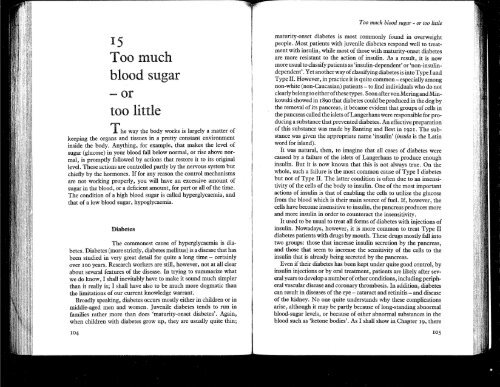John_Yudkin_-_Pure_White_and_Deadly_revised_1986_OCR
John_Yudkin_-_Pure_White_and_Deadly_revised_1986_OCR
John_Yudkin_-_Pure_White_and_Deadly_revised_1986_OCR
Create successful ePaper yourself
Turn your PDF publications into a flip-book with our unique Google optimized e-Paper software.
15<br />
Too much<br />
blood sugar<br />
-or<br />
too little<br />
T he way the body works is largely a matter of<br />
keeping the organs <strong>and</strong> tissues in a pretty constant environment<br />
inside the body. Anything, for example, that makes the level of<br />
sugar (glucose) in your blood fall below normal, or rise above normal,<br />
is promptly followed by actions that restore it to its original<br />
level. These actions are controlled partly by the nervous system but<br />
chiefly by the hormones. If for any reason the control mechanisms<br />
are not working properly, you will have an excessive amount of<br />
sugar in the blood, or a deficient amount, for part or all of the time.<br />
The condition of a high blood sugar is called hyperglycaemia, <strong>and</strong><br />
that of a low blood sugar, hypoglycaemia.<br />
Diabetes<br />
The commonest cause of hyperglycaemia is diabetes.<br />
Diabetes (more strictly, diabetes mellitus) is a disease that has<br />
been studied in very great detail for quite a long time - certainly<br />
over 100 years. Research workers are still, however, not at all clear<br />
about several features of the disease. In trying to summarize what<br />
we do know, I shall inevitably have to make it sound much simpler<br />
than it really is; I shall have also to be much more dogmatic than<br />
the limitations of our current knowledge warrant.<br />
Broadly speaking, diabetes occurs mostly either in children or in<br />
middle-aged men <strong>and</strong> women. Juvenile diabetes tends to run in<br />
families rather more than does 'maturity-onset diabetes'. Again,<br />
when children with diabetes grow up, they are usually quite thin;<br />
104<br />
Too much blood sugar - or too little<br />
maturity-onset diabetes is most commonly found in overweight<br />
people. Most patients with juvenile diabetes respond well to treatment<br />
with insulin, while most of those with maturity-onset diabetes<br />
are more resistant to the action of insulin. As a result, it is now<br />
more usual to classify patients as 'insulin-dependent' or 'non-insulindependent'.<br />
Yet another way of classifying diabetes is into Type I <strong>and</strong><br />
Type II. However, in practice it is quite common - especially among<br />
non-white (non-Caucasian) patients - to find individuals who do not<br />
clearly belong to either of these types. Soon after von Mering <strong>and</strong> Minkowski<br />
showed in 1890 that diabetes could be produced in the dog by<br />
the removal of its pancreas, it became evident that groups of cells in<br />
the pancreas called the islets of Langerhans were responsible for producing<br />
a substance that prevented diabetes. An effective preparation<br />
of this substance was made by Banting <strong>and</strong> Best in 1921. The substance<br />
was given the appropriate name 'insulin' (insula is the Latin<br />
word for isl<strong>and</strong>).<br />
It was natural, then, to imagine that all cases of diabetes were<br />
caused by a failure of the islets of Langerhans to produce enough<br />
insulin. But it is now known that this is not always true. On the<br />
whole, such a failure is the most common cause of Type I diabetes<br />
but not of Type II. The latter condition is often due to an insensitivity<br />
of the cells of the body to insulin. One of the most important<br />
actions of insulin is that of enabling the cells to utilize the glucose<br />
from the blood which is their main source of fuel. If, however, the<br />
cells have become insensitive to insulin, the pancreas produces more<br />
<strong>and</strong> more insulin in order to counteract the insensitivity.<br />
It used to be usual to treat all forms of diabetes with injections of<br />
insulin. Nowadays, however, it is more common to treat Type II<br />
diabetes patients with drugs by mouth. These drugs mostly fall into<br />
two groups: those that increase insulin secretion by the pancreas,<br />
<strong>and</strong> those that seem to increase the sensitivity of the cells to the<br />
insulin that is already being secreted by the pancreas.<br />
Even if their diabetes has been kept under quite good control, by<br />
insulin injections or by oral treatment, patients are likely after several<br />
years to develop a number of other conditions, including peripheral<br />
vascular disease <strong>and</strong> coronary thrombosis. In addition, diabetes<br />
can result in diseases of the eye - cataract <strong>and</strong> retinitis - <strong>and</strong> disease<br />
of the kidney. Noone quite underst<strong>and</strong>s why these complications<br />
arise, although it may be partly because of long-st<strong>and</strong>ing abnormal<br />
blood-sugar levels, or because of other abnormal substances in the<br />
blood such as 'ketone bodies'. As I shall show in Chapter 19, there<br />
105



